Twenty-seven states along with a number of national trade organizations and companies have filed legal challenges to EPA’s Clean Power Plan 2.0 (CPP 2.0) because of the rule’s legal overreach, unrealistic and expensive requirements, and threat to grid reliability. Recently, four of the nation’s largest electricity grid operators – MISO, PJM, SPP and ERCOT – jointly filed an amicus brief[1] with the D.C. Circuit in support of these challenges. The four grid operators are responsible for maintaining the reliability of the electric power grids that collectively cover all or parts of 30 states (blue in the map below) plus the District of Columbia.

The amicus brief was critical of the rule and EPA’s lack of concern about the harm the rule could cause to electric reliability. Below are a few representative excerpts from the grid operators’ brief:
Need for a Do-Over
The four grid operators “… request that the Court remand the Final Rule back to EPA, with instructions for it to adequately consider the … grid adequacy and reliability issues [grid operators] previously raised ….”
Harmful Impacts
- “[T]he compliance timelines and related provisions of the Rule are not workable and are destined to trigger an acceleration in the pace of premature retirements of EGUs that possess critical reliability attributes ….”
- “The Joint ISOs/RTOs are concerned that premature retirements of generating units that provide critical reliability attributes can have significant, negative consequences on reliability.”
- “Such inevitable and foreseeable premature retirement decisions resulting from the Rule’s timelines will substantially strain each of the Joint ISOs/RTOs’ ability to maintain the reliability of the electric power grid to meet the needs of the citizenry and the country’s economy.”
- The four grid operators “… are also concerned about the chilling impact these collective rules will have on the investment required to retain and maintain existing units that are needed to provide key reliability attributes and grid services before the Final Rule’s compliance date.”
- “The impact of the Final Rule must also be considered in conjunction with the numerous other proposed, pending, or existing environmental regulations that impact grid reliability and resource adequacy—all of which are resulting in a decline in reserve margin and premature retirement of dispatchable baseload resources (i.e., resources most currently in the form of coal and natural gas).”
EPA’s Lack of Analysis
- “In the Final Rule, EPA did not adequately consider or address potential impacts of the Rule on wholesale electricity markets or generation owners’ decisions to continue or cease operations.”
- “EPA has not adequately analyzed resource adequacy and reliability impacts in the Final Rule.”
- “[EPA’s] analysis did not recognize the more limited accredited value of renewables utilized by the Joint ISOs/RTOs in their reliability analyses as compared to the fossil generation predicted to retire as a result of the various EPA rules.”
- “EPA did not adequately address the impact of these rules holistically as part of the ‘energy requirements’ analysis required by Congress.”
EPA’s Indifference
- “… despite offers of assistance by [the grid operators] and promised coordination with other federal agencies, EPA did not adequately analyze such information before promulgating the Final Rule.”
- “The significant grid reliability issues—and [the grid operators’] proposed solutions—weren’t adequately addressed by EPA in response to the extensive record presented by [the grid operators] and others.”
- “EPA cannot simply disclaim responsibility to analyze these impacts by citing to the role of other agencies or the states.”
Other Problems
- “The [requirements] in EPA’s Final Rule governing GHG emissions from certain fossil-fuel-fired power plants are based on overly ambitious and inadequately supported assumptions.”
- “EPA’s proposed short-term remedy for grid reliability issues is too constraining to address reliability impacts resulting from the compliance strictures of the Rule.”
- The Rule’s “compliance deadlines … are based on overly ambitious and inadequately supported assumptions as to target dates for commercialization of CCS.”
- “EPA’s [technology] determination is overly optimistic regarding the commercial viability of CCS today and downplays the cost and practicalities of developing entirely new supporting infrastructure within the timeframes and at the costs projected.”
To see the grid operators’ amicus brief, click on this link.
[1] An amicus curiae is a person who offers additional information the court may want to consider. Amicus briefs are filed in appellate courts such as the D.C. Circuit. They show the court that its decision will impact people other than the parties, such as the 27 states, that are directly challenging the CPP 2.0.
